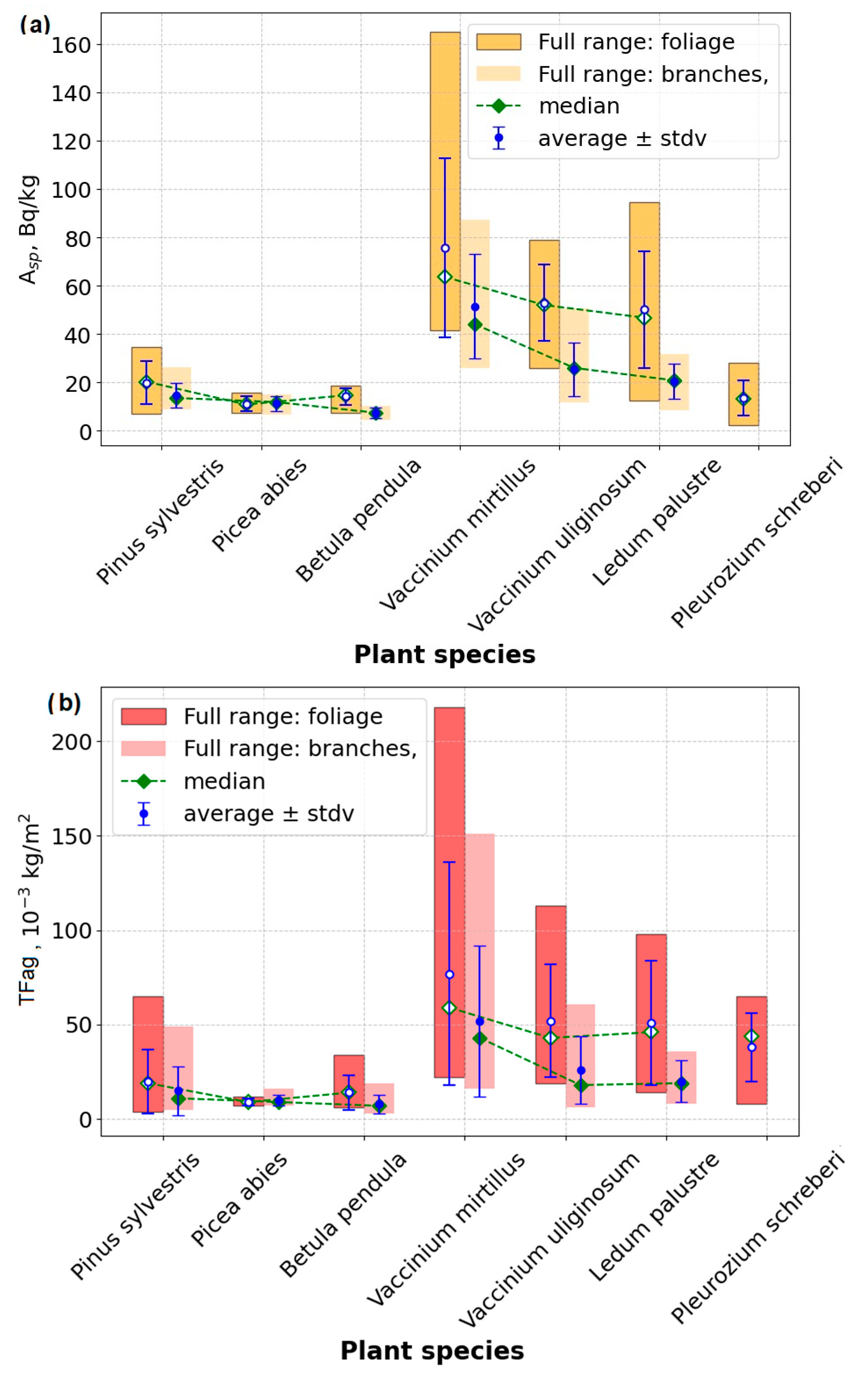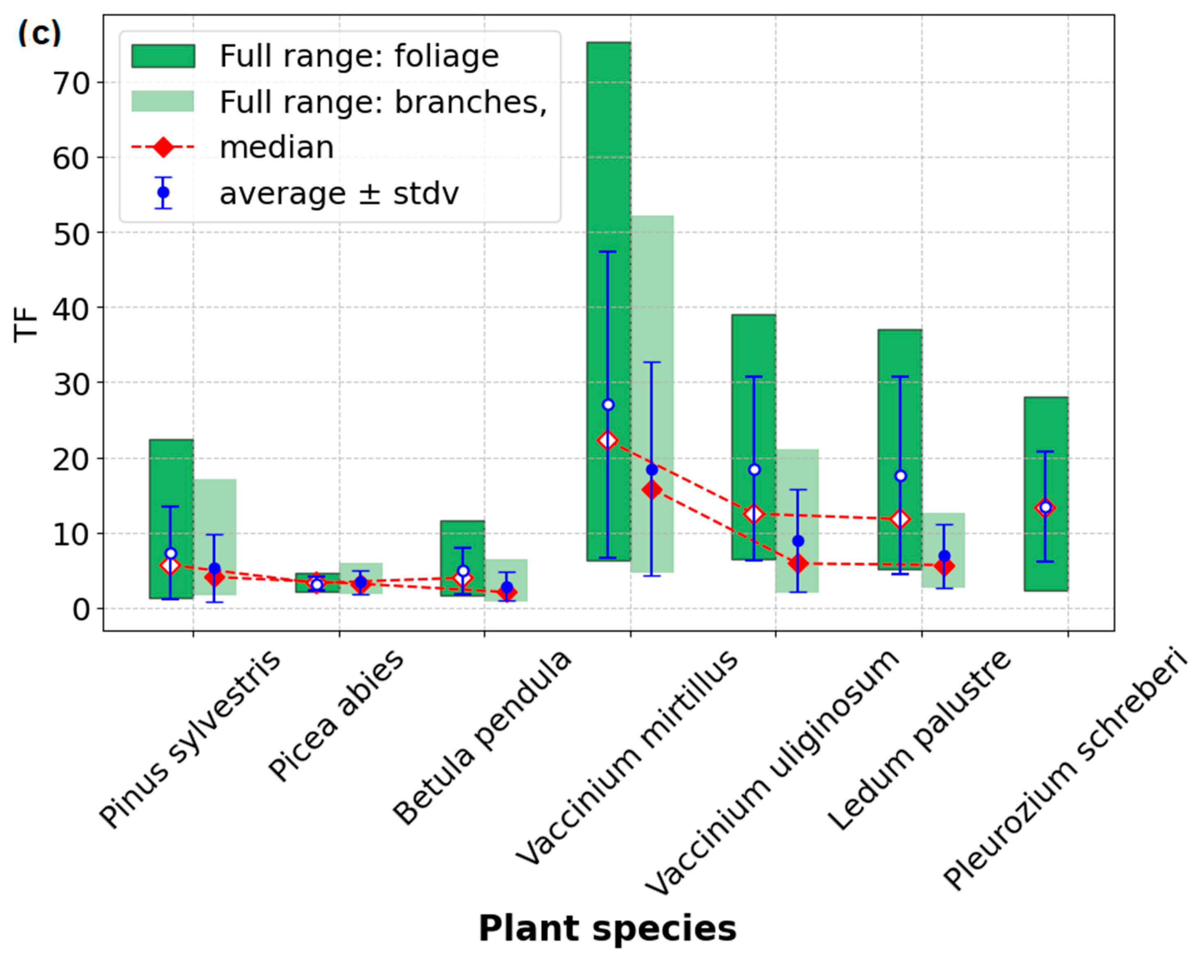Bioaccumulation of 137Cs: Vegetation Responses, Soil Interactions and Ecological Implications in the Northern Taiga Ecosystems
Abstract
1. Introduction
2. Materials and Methods
2.1. Study Area and Monitoring Sites
2.2. Vegetation and Soil Characteristics
2.3. Sampling and Analytical Methods
2.4. Data Analysis and Calculations
3. Results
3.1. Radiocesium Accumulation
3.2. Bioaccumulation Indicators
3.3. Accumulation Patterns
4. Discussion
Correlation Analysis and Soil Influence on 137Cs Mobility
5. Conclusions
Supplementary Materials
Author Contributions
Funding
Institutional Review Board Statement
Informed Consent Statement
Data Availability Statement
Conflicts of Interest
Appendix A
References
- Kellomäki, S.; Peltola, H.; Nuutinen, T.; Korhonen, K.T.; Strandman, H. Sensitivity of Managed Boreal Forests in Finland to Climate Change, with Implications for Adaptive Management. Phil. Trans. R. Soc. B 2008, 363, 2339–2349. [Google Scholar] [CrossRef] [PubMed]
- Holm, S.O. A Management Strategy for Multiple Ecosystem Services in Boreal Forests. J. Sustain. For. 2015, 34, 358–379. [Google Scholar] [CrossRef]
- Bunzl, K.; Kracke, W.; Schimmack, W. Migration of Fallout 239+240Pu, 241Am and 137Cs in the Various Horizons of a Forest Soil Under Pine. J. Environ. Radioact. 1995, 28, 17–34. [Google Scholar] [CrossRef]
- Fawaris, B.H.; Johanson, K.J. A Comparative Study on Radiocaesium (137Cs) Uptake from Coniferous Forest Soil. J. Environ. Radioact. 1995, 28, 313–326. [Google Scholar] [CrossRef]
- Johanson, K.J.; Kardell, L. Radiocaesium in Lingonberry, Bilberry, Cloudberry and Cranberry in Sweden. J. Radioecol. 1996, 4, 27–35. [Google Scholar]
- Almgren, S. Studies on the Gamma Radiation Environment in Sweden with Special Reference to 137Cs. Ph.D. Thesis, Göteborg University, Göteborg, Sweden, 2008. [Google Scholar]
- AMAP. Arctic Pollution 2009; Arctic Monitoring and Assessment Programme: Oslo, Norway, 2009; 83p. [Google Scholar]
- Gomez-Guzman, J.M. Level and Origin of 129I and 137Cs in Lichen Samples (Cladonia alpestris) in Central Sweden. J. Environ. Radioact. 2011, 102, 200–205. [Google Scholar] [CrossRef]
- Kudelsky, A.V.; Smith, J.T.; Ovsiannikova, S.V.; Hilton, J. Mobility of Chernobyl-Derived 137Cs in a Peatbog System within the Catchment of the Pripyat River, Belarus. Sci. Total Environ. 1996, 188, 101–113. [Google Scholar] [CrossRef]
- Korobova, E.; Ermakov, A.; Linnik, V. 137Cs and 90Sr Mobility in Soils and Transfer in Soil-Plant Systems in the Novozybkov District Affected by the Chernobyl Accident. Appl. Geochem. 1998, 13, 803–814. [Google Scholar] [CrossRef]
- Fesenko, S.V.; Soukhova, N.V.; Sanzharova, N.I.; Avila, R.; Spiridonov, S.I.; Klein, D.; Lucot, E.; Badot, P.-M. Identification of Processes Governing Long-Term Accumulation of 137Cs by Forest Trees Following the Chernobyl Accident. Radiat. Environ. Biophys. 2001, 40, 105–113. [Google Scholar] [CrossRef]
- Popova, M.B.; Lipatov, D.N.; Manakhov, D.V.; Kizeev, A.N.; Ushamova, S.F. Accumulation of 137Cs by Cladonia Lichens in the Impact Zone of the Kola Nuclear Power Plant. Biol. Bull. Russ. Acad. Sci. 2023, 50, 3123–3132. [Google Scholar] [CrossRef]
- Popova, M.B.; Goryachenkova, T.A.; Borisov, A.P.; Kazinskaya, E.I.; Lavrinovich, E.A.; Manakhov, D.V. Modes of Occurrence of Artificial Radionuclides in Soils in the Area of the Kola Nuclear Power Plant. Geochem. Int. 2021, 59, 983–990. [Google Scholar] [CrossRef]
- Popova, M.B.; Manakhov, D.V.; Kizeev, A.N.; Ushamova, S.F.; Lipatov, D.N.; Chirkov, A.Y.; Orlov, P.S.; Mamikhin, S.V. Contents and Distribution of 137Cs in Podzols in the Area of the Kola Nuclear Power Plant. Eurasian Soil Sci. 2020, 53, 986–994. [Google Scholar] [CrossRef]
- Goryachkin, S.V.; Egorov, N.Y.; Egorov, Y.A. To the Assessment of the State of Regions of Operating and Projected Kola NPP. In Ecology of Atomic Power Plant Regions (ERAS-4); AEP: Moscow, Russia, 1995; Volume 4, pp. 270–310. [Google Scholar]
- Bunzl, K.; Albers, B.P.; Shimmack, W.; Rissanen, K.; Suomela, M.; Puhakainen, M.; Rahola, T.; Steinnes, E. Soil to Plant Uptake of Fallout 137Cs by Plants from Boreal Areas Polluted by Industrial Emissions from Smelters. Sci. Total Environ. 1999, 234, 213–221. [Google Scholar] [CrossRef]
- Shershakov, V.M.; Bulgakov, V.G.; Kryshev, I.I.; Vakulovskiy, S.M.; Katkova, M.N.; Kryshev, A.I. Radiation Situation on the Territory of Russia and Neighboring States in 2020; FGBU “NPO Typhoon”: Obninsk, Russia, 2021; 330p. [Google Scholar]
- Environmental Safety Report for 2021; Kola NPP: Polyarnye Zori, Russia, 2022; 44p.
- IUSS Working Group WRB. World Reference Base for Soil Resources: International Soil Classification System for Naming Soils and Creating Legends for Soil Maps, 4th ed.; International Union of Soil Sciences (IUSS): Vienna, Austria, 2022. [Google Scholar]
- Joint Committee for Guides in Metrology (JCGM). Evaluation of Measurement Data—Guide to the Expression of Uncertainty in Measurement; JCGM: Daly City, CA, USA, 2008. [Google Scholar]
- Morozova, O.V.; Zaugolnova, L.B.; Isaeva, L.G.; Kostina, V.A. Classification of Boreal Forests in the North of European Russia. I. Oligotrophic Coniferous Forests. Veg. Russia 2008, 13, 61–81. [Google Scholar] [CrossRef]
- Sidelnikov, N.I.; Kovalev, N.I. (Eds.) Atlas of Medicinal Plants of Russia, 2nd ed.; Sci. Ed., revised and expanded; All-Russian Scientific Research Institute of Medicinal and Aromatic Plants: Moscow, Russia, 2021; 646p, ISBN 978-5-87019-094-5. [Google Scholar]
- Rantavaara, A.; Vetikko, V.; Raitio, H.; Aro, L. Seasonal variation of the 137Cs level and its relationship with potassium and carbon levels in conifer needles. Sci. Total Environ. 2012, 441, 194–208. [Google Scholar] [CrossRef] [PubMed]
- Konopleva, I.; Klemt, E.; Konoplev, A.; Zibold, G. Migration and bioavailability of 137Cs in forest soil of southern Germany. J. Environ. Radioact. 2009, 100, 315–321. [Google Scholar] [CrossRef]
- Zhu, Y.G.; Smolders, E. Plant uptake of radiocaesium: A review of mechanisms, regulation and application. J. Exp. Bot. 2000, 51, 1635–1645. [Google Scholar] [CrossRef]
- Fesenko, S.V.; Soukhova, N.V.; Sanzharova, N.I.; Avila, R.; Spiridonov, S.; Klein, D.; Badot, P.-M. 137Cs Availability for Soil to Understory Transfer in Different Types of Forest Ecosystems. Sci. Total Environ. 2001, 269, 87–103. [Google Scholar] [CrossRef]
- Kaunisto, S.; Aro, L.; Rantavaara, A. Effect of fertilisation on the potassium and radiocaesium distribution in tree stands (Pinus sylvestris L.) and peat on a pine mire. J. Environ. Radioact. 2002, 117, 111–119. [Google Scholar] [CrossRef]
- Vetikko, V.; Rantavaara, A.; Moilanen, M. Uptake of 137Cs by berries, mushrooms and needles of Scots pine in peatland forests after wood ash application. J. Environ. Radioact. 2010, 110, 1055–1060. [Google Scholar] [CrossRef]
- Galán, P.R. Behaviour of 137Cs in a raised bog in central Sweden. Master’s Thesis, Sveriges Lantbruksuniversitet, Uppsala, Sweden, 2006. [Google Scholar]
- Vinichuk, M.; Simonsson, M.; Larsson, M.; Rosén, K. Long-term transfer of 137Cs in sensitive agricultural environments after the Chornobyl fallout in Sweden. J. Environ. Radioact. 2025, 282, 107621. [Google Scholar] [CrossRef] [PubMed]
- Vanheukelom, M.; Haenen, N.; Almahayni, T.; Sweeck, L.; Weyns, N.; Van Hees, M.; Smolders, E. The clay mineralogy rather that the clay content determines radiocaesium adsorption in soils. EGUsphere 2024, 2024, 1–55. [Google Scholar]
- Okhrimchuk, D.; Hurtevent, P.; Gonze, M.A.; Simon-Cornu, M.; Roulier, M.; Carasco, L.; Orjollet, D.; Nicolas, M.; Probst, A. Long-term behaviour of Cs-137, Cs-133 and K in beech trees of French forests. J. Environ. Radioact. 2024, 277, 107450. [Google Scholar] [CrossRef]
- Rosen, K.; Vinichuk, M.; Johanson, K.J. 137Cs in a raised bog in central Sweden. J. Environ. Radioact. 2009, 100, 534–539. [Google Scholar] [CrossRef]
- Maekawa, A.; Momoshima, N.; Sugihara, S.; Ohzawa, R.; Nakama, A. Analysis of 134Cs and 137Cs distribution in soil of Fukushima prefecture and their specific adsorption on clay minerals. J. Radioanal. Nucl. Chem. 2015, 303, 1485–1489. [Google Scholar] [CrossRef]
- Tsukada, H.; Yamada, D.; Yamaguchi, N. Accumulation of 137Cs in aggregated organomineral assemblage in pasture soils 8 years after the accident at the Fukushima Daiichi nuclear power plant. Sci. Total Environ. 2022, 806, 150688. [Google Scholar] [CrossRef] [PubMed]
- Manaka, K.; Kato, S.; Sakamoto, R.; Yamakage, H.; Uema, T.; Kawai, S.; Shibata, M.; Hiratsuka, I.; Nakachi, S.; Onoue, T.; et al. Impact of coronavirus disease 2019 on medical practice in endocrine and metabolic diseases in Japan: A nationwide surveillance study conducted by the Japan Endocrine Society. Endocr. J. 2024, 71, 499–514. [Google Scholar] [CrossRef]
- Koarashi, J.; Atarashi-Andoh, M.; Nishimura, S. Effect of soil organic matter on the fate of 137Cs vertical distribution in forest soils. Ecotoxicol. Environ. Saf. 2023, 262, 115177. [Google Scholar] [CrossRef]



| 137Cs Content | Observation Zone | Sanitary Protection Zone | Background | ||
|---|---|---|---|---|---|
| Specific activity | (n = 10) | Bq/kg | t-Test | Bq/kg | t-Test |
| Branches | 14.6 | 9.9 | 2.94 | 21.4 | −4.27 |
| Fir needles | 19.9 | 13.3 | 2.32 | 26.9 | −2.3 |
| Index | K2O, mg/100 g | Ca2+ mmol/100 g | Mg2+ mmol/100 g | Litter Storage kg/m2 | Organic Matter, kg/m2 | K Storage, kg/m2 |
|---|---|---|---|---|---|---|
| Asp branches 137Cs, Bq/kg | −0.30 | −0.42 | −0.26 | −0.29 | −0.06 | −0.57 |
| Asp fir needles, 137Cs, Bq/kg | −0.49 | −0.55 | −0.45 | −0.66 | −0.20 | −0.60 |
| TF branches | −0.76 | −0.87 | −0.64 | −0.59 | −0.55 | −0.71 |
| TF in fir needles | −0.67 | −0.80 | −0.75 | −0.75 | −0.58 | −0.65 |
| TFag in branches n·10−3 m2/kg | −0.69 | −0.50 | −0.38 | −0.56 | −0.40 | −0.83 |
| TFag in fir needles, n·10−3 m2/kg | −0.74 | −0.68 | −0.75 | −0.84 | −0.53 | −0.76 |
Disclaimer/Publisher’s Note: The statements, opinions and data contained in all publications are solely those of the individual author(s) and contributor(s) and not of MDPI and/or the editor(s). MDPI and/or the editor(s) disclaim responsibility for any injury to people or property resulting from any ideas, methods, instructions or products referred to in the content. |
© 2025 by the authors. Licensee MDPI, Basel, Switzerland. This article is an open access article distributed under the terms and conditions of the Creative Commons Attribution (CC BY) license (https://creativecommons.org/licenses/by/4.0/).
Share and Cite
Popova, M.; Kriuchkov, N.R.; Myasnikov, I.; Kizeev, A.; Ushamova, S.; Manakhov, D. Bioaccumulation of 137Cs: Vegetation Responses, Soil Interactions and Ecological Implications in the Northern Taiga Ecosystems. Life 2025, 15, 774. https://doi.org/10.3390/life15050774
Popova M, Kriuchkov NR, Myasnikov I, Kizeev A, Ushamova S, Manakhov D. Bioaccumulation of 137Cs: Vegetation Responses, Soil Interactions and Ecological Implications in the Northern Taiga Ecosystems. Life. 2025; 15(5):774. https://doi.org/10.3390/life15050774
Chicago/Turabian StylePopova, Marina, Nikita R. Kriuchkov, Ivan Myasnikov, Alexei Kizeev, Svetlana Ushamova, and Dmitriy Manakhov. 2025. "Bioaccumulation of 137Cs: Vegetation Responses, Soil Interactions and Ecological Implications in the Northern Taiga Ecosystems" Life 15, no. 5: 774. https://doi.org/10.3390/life15050774
APA StylePopova, M., Kriuchkov, N. R., Myasnikov, I., Kizeev, A., Ushamova, S., & Manakhov, D. (2025). Bioaccumulation of 137Cs: Vegetation Responses, Soil Interactions and Ecological Implications in the Northern Taiga Ecosystems. Life, 15(5), 774. https://doi.org/10.3390/life15050774






